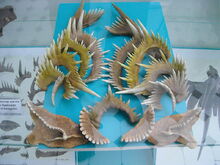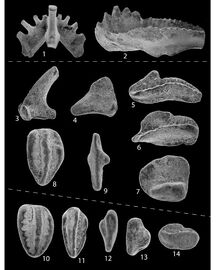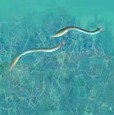
Remains of the animal Manticolepis suberecta

A wide range of conodont teeth
Conodonts are extinct chordates resembling eels, classified in the class Conodonta. For many years, they were known only from tooth-like microfossils now called conodont elements, found in isolation. Knowledge about soft tissues remains relatively sparse to this day. The animals are also called Conodontophora (conodont bearers) to avoid ambiguity. In 2012 they discovered a Conodont that lived in 230-228 that time had dinosaurs. They lived 495 to 228 (Ordovician had the most). Conodonts are classified as Vertabrate but not a fish and lived in the Cambrian (Late).

The conodont genus Manticolepis
Description[]
The eleven known fossil imprints of conodont animals depict an eel-like creature with 15 or, more rarely, 19 elements forming a bilaterally symmetrical array in the head. This array constituted a feeding apparatus radically different from the jaws of modern animals. There are three forms of teeth, coniform cones, ramiform bars, and pectiniform platforms, which may have performed different roles. The organisms range from a centimeter or so to the giant Prommisum, 40 cm in length. It is now widely agreed that conodonts had large eyes, fins with fin rays, chevron-shaped muscles and a notochord. The entire class of Conodonts are postulated to have been wiped out by the Triassic–Jurassic extinction event, which occurred roughly 200 million years ago.
Ecology[]
The "teeth" of some conodonts have been interpreted as filter-feeding apparatuses, filtering out plankton from the water and passing it down the throat. Others have been interpreted as a "grasping and crushing array". The lateral position of the eyes makes a predatory role unlikely. The preserved musculature hints that some conodonts (Promissum at least) were efficient cruisers but incapable of bursts of speed.
Classification and phylogeny[]
As of 2012, scientists classify the conodonts in the phylum Chordata on the basis of their fins with fin rays, chevron-shaped muscles and notochord.[1]
Milsom and Rigby envision them as vertebrates similar in appearance to modern hagfish and lampreys,[2] and phylogenetic analysis suggests they are more derived than either of these groups.[3] However, this analysis comes with one caveat: early forms of conodonts, the protoconodonts, appear to form a distinct clade from the later paraconodonts and euconodonts. Protoconodonts likely represent a stem group to the phylum that includes chaetognath worms; this conclusion suggests that chaetognaths are not close relatives of true conodonts.[4] Moreover, some analyses do not regard conodonts as either vertebrates or craniates, because they lack the main characteristics of these groups.[5]
Gallery[]
References[]
- ↑ Briggs, D. (May 1992). "Conodonts: a major extinct group added to the vertebrates". Science 256 (5061): 1285–1286. DOI:10.1126/science.1598571. PMID 1598571.
- ↑ Milsom, Clare; Rigby, Sue (2004). "Vertebrates". Fossils at a Glance. Victoria, Australia: Blackwell Publishing. p. 88. ISBN 0-632-06047-6.
- ↑ Donoghue, P.C.J. (2000). "Conodont affinity and chordate phylogeny". Biological Reviews 75 (2): 191–251. DOI:10.1017/S0006323199005472. PMID 10881388. Retrieved on 2008-04-07.
- ↑ Szaniawski, H. (2002). "New evidence for the protoconodont origin of chaetognaths". Acta Palaeontologica Polonica 47 (3): 405.
- ↑ Turner, S., Burrow, C.J., Schultze, H.P., Blieck, A., Reif, W.E., Rexroad, C.B., Bultynck, P., Nowlan, G.S. (2010). "False teeth: conodont-vertebrate phylogenetic relationships revisited". Geodiversitas 32 (4): 545–594. DOI:10.5252/g2010n4a1.
